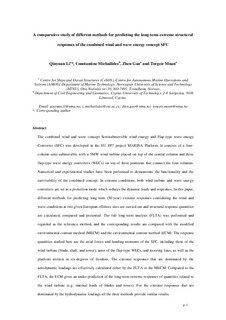| dc.contributor.author | Li, Qinyuan | |
| dc.contributor.author | Michailides, Constantine | |
| dc.contributor.author | Gao, Zhen | |
| dc.contributor.author | Moan, Torgeir | |
| dc.date.accessioned | 2019-02-27T09:50:20Z | |
| dc.date.available | 2019-02-27T09:50:20Z | |
| dc.date.created | 2018-09-26T13:57:09Z | |
| dc.date.issued | 2018 | |
| dc.identifier.citation | Journal of Engineering for the Maritime Environment (Part M). 2018, 232 (1), 85-96. | nb_NO |
| dc.identifier.issn | 1475-0902 | |
| dc.identifier.uri | http://hdl.handle.net/11250/2587730 | |
| dc.description.abstract | The combined wind and wave concept semisubmersible wind energy and flap-type wave energy converter was developed in the EU FP7 project MARINA Platform. It consists of a four-column semisubmersible with a 5-MW wind turbine placed on top of the central column and three flap-type wave energy converters on top of three pontoons that connect the four columns. Numerical and experimental studies have been performed to demonstrate the functionality and the survivability of the combined concept. In extreme conditions, both wind turbine and wave energy converters are set in a protection mode which reduces the dynamic loads and responses. In this article, different methods for predicting long-term (50-year) extreme responses considering the wind and wave conditions at two given European offshore sites are carried out, and structural response quantities are calculated, compared and presented. The full long-term analysis was performed and regarded as the reference method, and the corresponding results are compared with the modified environmental contour method and the environmental contour method. The response quantities studied here are the axial forces and bending moments of the semisubmersible wind energy and flap-type wave energy converter, including those of the wind turbine (blade, shaft and tower), arms of the flap-type wave energy converters and mooring lines, as well as the platform motion in 6 degrees of freedom. The extreme responses that are dominated by the aerodynamic loadings are effectively calculated either by the full long-term analysis or the modified environmental contour method. Compared to the full long-term analysis, the environmental contour method gives an under-prediction of the long-term extreme responses of quantities related to the wind turbine (e.g. internal loads of blades and tower). For the extreme responses that are dominated by the hydrodynamic loadings, all the three methods provide similar results. | nb_NO |
| dc.language.iso | eng | nb_NO |
| dc.publisher | SAGE Publications | nb_NO |
| dc.title | A comparative study of different methods for predicting the long-term extreme structural responses of the combined wind and wave energy concept semisubmersible wind energy and flap-type wave energy converter | nb_NO |
| dc.type | Journal article | nb_NO |
| dc.type | Peer reviewed | nb_NO |
| dc.description.version | acceptedVersion | nb_NO |
| dc.source.pagenumber | 85-96 | nb_NO |
| dc.source.volume | 232 | nb_NO |
| dc.source.journal | Journal of Engineering for the Maritime Environment (Part M) | nb_NO |
| dc.source.issue | 1 | nb_NO |
| dc.identifier.doi | 10.1177/1475090217726886 | |
| dc.identifier.cristin | 1614094 | |
| dc.relation.project | Norges forskningsråd: 223254 | nb_NO |
| dc.description.localcode | © 2018. This is the authors' accepted and refereed manuscript to the article. The final authenticated version is available online at: https://doi.org/10.1177%2F1475090217726886 | nb_NO |
| cristin.unitcode | 194,64,20,0 | |
| cristin.unitname | Institutt for marin teknikk | |
| cristin.ispublished | true | |
| cristin.fulltext | postprint | |
| cristin.qualitycode | 1 | |
